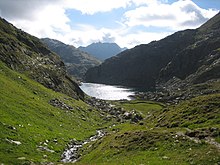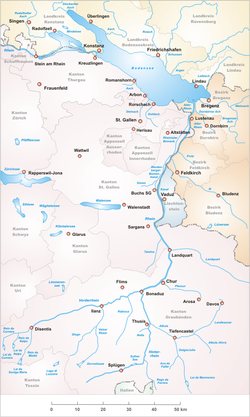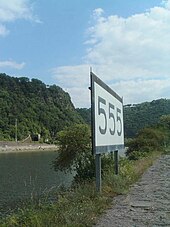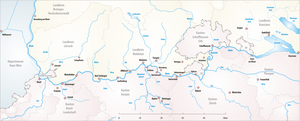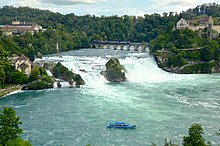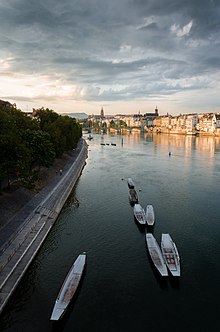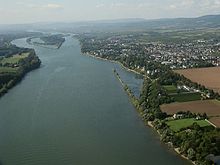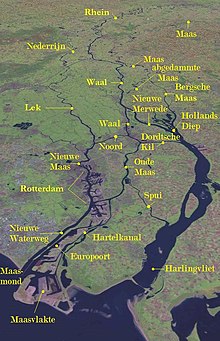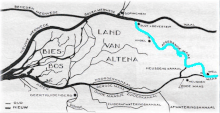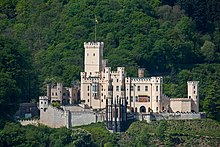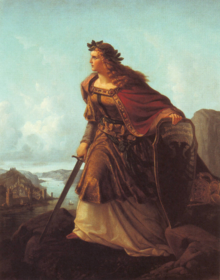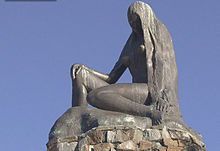Rhine
The Rhine River (German: Rhein; French: Rhin; Dutch: Rijn; Romansh: Rain) is a major river in Europe, being the most used waterway in the European Union (EU). With a length of 1230 km (14th longest in Europe), is navigable in a section of 883 km between Basel (Switzerland) and its delta in the North Sea. Its average flow is 2100 m³/s, and it forms a common delta with the Meuse River. Among the largest and most important cities of the Rhine are Basel (Switzerland), Strasbourg (France), Cologne, Düsseldorf (Germany) and Rotterdam (Netherlands).
Together with the Danube, the Rhine made up most of the northern border (the limes) of the Roman Empire. The Romans called it Rhēnus. Later, the French and Germans fought on this river to assert their power. The Rhine also served as an important route for trade, generating wealth for various peoples, from Frisians and Vikings to the merchants of the Hanseatic League and the Golden Age. from Amsterdam.
Initially, it was the textile industry that discovered the benefits of the Rhine. Then came the chemical industry, and in recent decades some of the world's largest steel, automotive, textile and chemical plants have been built on the banks of the river, with canals connecting the Rhine to the Baltic Sea, the Mediterranean Sea and the Atlantic Ocean. However, free shipping of goods along the Rhine has only been possible since 1868, when the Mannheim Convention was signed.
The Rhine crosses very different regions, which affects its regime and its possibilities of use. It also has outstanding points within European geography such as the Rhine Falls in Schaffhausen, which constitute the waterfall with the highest average flow in the continent.
The river has also played a central role in shaping the culture of Europe. Thus, among the various cultural and recreational activities, during the warmer months, thousands of people bathe in its waters as it passes through Switzerland.
General information
Statistics
The Rhine, which has been considered for several decades to be 1320 km in length, is actually 1232.7 km Bruno Kremer, a biologist at the University of Cologne, raised the question of the exact length of the Rhine in early 2010, suspecting a reversal of the hundreds and tens digits into an initial reference source, later reproduced by all others. The International Commission for the Hydrology of the Rhine Basin resolved the issue in January 2015, in favor of 1232, 7 km, after collecting data from the Swiss, German and Dutch authorities.
A length of 883 km is accessible to large vessels. At its mouth, its average flow is about 2330 m³/s; the maximum measured reached 12,000 m³/s (in 1926), the minimum 600 m³/s (in 1947). The catchment area of the Rhine covers 198,000 km².
Basin
The Rhine basin borders (starting from the west and in a clockwise direction) with the basins of the Meuse, the Ems, the Weser and the Elbe ((all flow into the North Sea), the Danube (Black Sea), the Po (Adriatic Sea) and the Rhône (Mediterranean Sea). Its basin also extends into France (about half of the new Grand Est region), almost all of Luxembourg, and also drains the waters of the Sûre in Belgium and del Reno di Lei in Italy.
The Rhine flows in a general north-northwest direction through very different natural regions, such as the Alps, the Swiss Pre-Alps, the Swiss Plateau, the Rhenish Trench, the Mittelgebirgsschwelle (Middle Mountain Gap) or the plain of the lower Rhine.
The river runs through Switzerland, Austria, Germany, and the Netherlands. It serves as Switzerland's border with Liechtenstein, with Austria and with Germany; and marks the border between Germany and France.
The Rhine river basin is approximately 198,000 km² and spans nine countries:
- Switzerland: 28 000 km2 (more than half of the country ' s surface mainly due to its affluent Aar);
- Italy: less than 100 km2;
- Liechtenstein: 160 km2the whole country;
- Austria: 2400 km2;
- Germany: 106 000 km2almost a third of the country;
- France: 24 000 km2;
- Luxembourg: 2500 km2almost the whole country;
- Belgium: less than 800 km2;
- Netherlands: 34 000 km2more than three quarters of the country.
Etymology
The name Rin is of Celtic origin and means 'watercourse' (as in Old Irish rían 'sea, ocean').
Geography
In the Late Cenozoic, the waters of the current Valaisan basins of the Rhine and Rhone flowed towards the seas that later occupied the Hungarian plain. Until Paleolithic times, the Alpine Rhine continued to feed the Danube, gradually diverting from it to take its present westward route.
Between the Black Forest and the Vosges, under the Rhine plain, flows an “invisible river”. Europe's largest groundwater reservoir stretches peacefully to the north. Sometimes it rises to the surface forming numerous wetlands.
The length of the Rhine is conventionally measured in "Rhine-kilometres" (Rheinkilometer), a scale introduced in 1939 that runs from the Old Rhine Bridge in Konstanz (0 km) to the Hook of Holland (1036.20 km). The river has been significantly shortened from its natural course due to a series of canalization projects completed in the 19th and 20th centuries. The "full length of the Rhine", including Lake Constance and the Alpine Rhine is more difficult. to measure objectively; it was cited as 1232 km by the Dutch Rijkswaterstaat in 2010.
Name
The Rhine flows through several countries and language areas, and various sections of the river have their own names. Sometimes confusion arises because different sections, after translation, have been given the same name—such as Niederrhein and Nederrijn—and other sections have different names depending on the country, which adds to the confusion. The obvious choice would be not to translate, which would avoid confusion, but in common parlance that practice is already well established. The Rhine, from Switzerland through Germany to the Netherlands, is called successively in German:
- Alpenrhein (Alpine river): to Lake Constance (partly the border between Switzerland and successively Liechtenstein and Austria). The Alpine Rhine has two higher courses: the Vorderrhein (Previous or front Rhine) and the rear or rear Rhine, joining in Reichenau - Tamins (Graubünden). From this point the river is called Rhine dry. The Rhine flows through Lake Constance and continues as a river again from Stein am Rhein.
- Hochrhein (Alto Rin): from Constance (partially the border between Switzerland and Germany).
The part of the confluence with the Aare is called Niederrhein by the Swiss. In Schaffhausen is the Rheinfall, the largest waterfall in Europe.
In Germany, the following names are also used:
- Hochrheinto Basel (Swiss-German border).
- Oberrhein (Rin Alto or Alto Rin), to Bingen (partially the German-French border). Due to internal navigation, only the section on Mannheim is called "Oberrhein". In that part, a superior Rhine shed is often used.
- Mittelrhein (Middle Ring) to Bonn. The Rhine, with the Loreley as a characteristic point, runs here, among other things, along the Eifel.
- Niederrhein (Rin Bajo or Lower Rhine), to the German-Dutch border. From Düsseldorf, this name also indicates a region, the Lower Rhine.
In the Netherlands, the Rhine (Rijn) forks and parts of the original channel have been excavated for water management, flood safety and improved shipping. The different parts, often with very different characteristics, each have their own name. Also, most sections of the original Rhine (from the border to Katwijk) are still colloquially known as Rhine, but the specific name of the section is preferred. When the Rhine leaves Germany, the waterway is called:
- Boven-Rijn (Alto Rin) from the border in Spijk to Pannerdense Kop. Therefore, it includes theBijlandsch Kanaal and, in the Dutch language, it also includes the German left half of the river from Spijk to Millingen, while this section of the border river is called Niederrhein in German.
- Canal Bijlandsch from the shipyard in Tolkamer to the center of Millingen. This section is preferably also called Alto Rin.
The fork of the Rhine was traditionally at Schenkenschanz. In the 18th century, a second junction point was built one kilometer downstream from Millingen: the Pannerdense Kop. The first meander of the original Waal was then excavated. The Pannerdense Kop is the beginning of the Rhine delta. The Boven-Rijn is divided into:
- The Waal, this branch of the south, is now the main current. It passes through Nijmegen and Woudrichem, where the river Mosa and Waal used to flow, the Waal becomes Boven-Merwede. The Boven-Merwede is divided into Beneden-Merwede in Werkendam, which is divided into Oude Maas and Noord in Dordrecht, and excavated Nieuwe Merwede. The latter leads to Hollandsch Diep, where it merges with Amer, the continuation of the Maas. A little later, the Dordtsche Kil off, entering Oude Maas near Dordrecht. Just after Willemstad, Hollandsch Diep becomes Haringvliet, which flows into the North Sea through large locks.
- The Pannerdensch channel between Pannerdense Kop and Kandia's pumping station, opposite the Angeren brick factory. This excavated section opens to Nederrijn, the northern branch, which was originally the main branch. Sometimes the part between the Kandia pumping station and the IJsselkop is also called the Pannerdensch Canal. However, this is incorrect.
Between Westervoort and Arnhem-South lies the IJsselkop. Here the IJssel branches off the Nederrijn.
- The IJssel, which goes north, passes through Zutphen and Deventer and flows into the IJsselmeer right after Kampen through the Ketelmeer.
- The Nederrijn continues to go through Arnhem and Rhenen to Wijk bij Duurstede. There is another division in:
- Kromme Rijn, the old main branch, which began to accumulate sediments already in the centuryIX and was denied in 1122. This ancient branch runs through Utrecht, parts of the Oude Gracht that were once Rhine. The Vecht is separated into the Weerdsluis. This ancient river flows north and flows into the IJmeer in Muiden. The Rhine continues westward as Leidse Rijn to Harmelen, a section excavated in the Middle Ages, and Oude Rijn through Leiden to Katwijk, where it flows into the North Sea.
- The Lek River, so this is completely the continuation of the Nederrijn. In Slikkerveer there is a confluence with the Noord and this river is called Nieuwe Maas. A lot of Waal water is added across the north, but almost no Maas water. In the Botlek area, the Oude Maas leads to the Nieuwe Maas and then is called Scheur. In Maassluis, the Nieuwe Waterweg excavated begins, ending in the North Sea. The original mouth of the Oude Maas is closed.
| Name section | Description | Length | Average rate | Altitude | Left affluent | Right affluent |
| Sources and headers | The various sources and headers that form the Previous and Rin Posterior within the Grisones, Switzerland | 76 km | 114 m3/s | 584 m | Aua Russein, Schmuèr | Rein da Tuma, Rein da Curnera, Rein da Medel, Rein da Sumvitg (Rein da Vigliuts), Glogn (Valser Rhine), Rabiusa, Rein Posteriur/Hinterrhein (right: Ragn da Ferrera, Albula/Alvra (left: Gelgia; right: Landwasser) |
| Rin Alpino (Alpenrhein) | Tram that crosses the valley of the Rhine of the Grisones and San Galo (partly part of the border between Liechtenstein-Switzerland and Austria-Switzerland) | c. 90 km | 231 m3/s (40-2665 m3/s) | 400 m | Tamina | Plessur, Landquart, Ill |
| Lake Constance | Lake Constance, including the short channel called Seerhein in Constance, which connects Obersee and Untersee | c. 60 km | 395 m | Alter Rhein (Rheintaler Binnenkanal), Goldach | Dornbirner Ach, Bregenzer Ach, Leiblach, Argen, Schussen, Rotach, Brunnisaach, Lipbach, Seefelder Aach, Radolfzeller Aach | |
| Alto Rin (Hochrhein) | From the departure of Lake Constance to Basel, forming a substantial part of the border between Germany and Switzerland. | c. 150 km | 1300 m3/s | 246 m | Thur, Töss, Glatt, Aar, Ergolz, Birs | Wutach |
| Superior (Hochrhein) | From Basel to Bingen forming the Upper Rhine Plain and in its upper course the French-German border | 362 km | 79 m | Ill, Moder, Lauter, Nahe | Wiese, Elz, Kinzig, Rench, Acher, Murg, Alb, Pfinz, Neckar, Meno (Main) | |
| Medium ring (Mittelrhein) | The Middle Rhine between Bingen and Bonn or Cologne is completely inside Germany, passing through the Rhine Gorges | 159 km | 45 m | Moselle, Nette, Ahr | Lahn, Wied, Sieg | |
| Lower Rhine (Niederrhein) | Tramo downstream of Bonn, passing through the Lower Rhine region of North Rhine-Westphalia | 177 km | 11 m | Erft | Wupper, Düssel, Ruhr, Emscher, Lippe | |
| Nederrijn | The Nederrijn or Nether Rhine (oude Rijn abbreviation within the Rhine-Mosa-Scalda delta in the Netherlands) | c. 50 km | 2900 m3/s | 0 m | Mosa (Meuse, Maas) | Oude IJssel, Berkel |
- ↑ Longitude of the previous Rhine, including the length of the Rein da Medel.
- ↑ Constance to Basel: Rheinkilometer 0-167.
- ↑ In the confluence of the Aarand Rin, the Aarat 560 m3/s carries more average water than the Rhine with 439 m3/s, so hydrographically having the Rhine should be a tributary on the right of the Aar.
- ↑ Basel to Bingen: Rheinkilometer 167-529.
- ↑ Bingen to Cologne: Rheinkilometer 529-688 (159 km); there is no unequivocal definition of the Middle Rhine, and some consider that it begins upstream, in the mouth of the Meno.
- ↑ Rheinkilometer 688–865.5 (177.5 kmfrom Cologne to the German-Dutch border.
- ↑ The total discharge of the Rhine is subject to significant fluctuations and the average values cited vary according to the sources; the total flow considered here consists of: Maasmond: 1450 m3/s, Haringvliet: 820 m3/s, Den Oever: 310 m3/s, Kornwerderzand: 220 m3/s, IJmuiden: 9 m3/s, Scheldt-Rhine Canal 10 m3/s
Headers and fonts
Fonts
The Rhine is named without distinctive appurtenances only from the confluence of the Fore Rhine/Vorderrhein and the Hind Rhine/Hinterrhein together with Reichenau at Tamins. Above this point is the extensive catchment basin of the headwaters of the Rhine. It belongs almost exclusively to the Swiss canton of Grisons, running from the Gotthard massif in the west through a valley lying in Ticino and Italy, in the south, to the Flüela pass in the east. The Rhine is one of the four main rivers that originate in the Gotthard region, along with the Ticino, Rhône and Reuss.
Traditionally, Lake Toma, near the Oberalp Pass in the Gotthard region, is considered the source of the Fore Rhine and the Rhine as a whole. The Back Rhine rises in the Rheinwald below the Rheinwaldhorn.
Anterior Kidney and Posterior Kidney
The source of the river is generally considered to be north of Lai da Tuma/Tomasee in Rein Anteriur/Vorderrhein, though its southern tributary Rein da Medel is actually longer before its confluence with the Anterior Rhine near Disentis.
- The Previous Rhine (in romanche: Rein Anteriurin German: Vorderrhein) arises from Lai da Tuma/Tomaseenear the Oberalp Pass and pass through the impressive Ruinaulta formed by the largest visible rock slide of the Alps, the Flims Rockslide.
- The Back (in romanche: Rein Posteriurin German: Hinterrhein) part of the Paradies glacier, near the Rheinwaldhorn. One of his tributaries, the Reno di Lei, dewater the Valle di Lei politically Italian territory. After three main valleys separated by the two gorges, Roflaschlucht and ViamalaHe comes to Reichenau in Tamins.
The Anterior Rhine arises from numerous streams that spring from the upper part of Surselva and flow in an easterly direction. One of the fountains is Lai da Tuma (2345 m) with the Rein da Tuma, which it is usually indicated as the source of the Rhine, which flows through it.
In it flow tributaries from the south, some longer, others of equal length, such as the Rein da Medel, the Rein da Maighels or the Rein da Curnera. The Cadlimo Valley in the canton of Ticino is drained by the Reno di Medel, which crosses the main Alpine ridge from the south. All streams in the source area are partly artificially captured, sometimes completely, and are sent to storage reservoirs for local hydroelectric power plants.
The culminating point of the Forer Rhine drainage basin is Piz Russein in the Tödi massif of the Glarus Alps, 3613 m above sea level. sea. It begins with the stream Aua da Russein (lit.: 'Water of the Russein').
In its lower course, the Fore Rhine flows through a gorge called Ruinaulta (Flims Rockslide). The entire section of the Previous Rhine to the confluence of the Alpine Rhine at Reichenau in Tamins is accompanied by a long-distance hiking trail called Senda Sursilvana.
The Back Rhine flows first east-northeast, then north. It runs through the three valleys called Rheinwald, Schams and Domleschg-Heinzenberg. The valleys are separated by Rofla gorge and Viamala gorge. Its sources are in the Adula Alps (Rheinwaldhorn, Rheinquellhorn and Güferhorn).
The Avers Rhine is joined from the south. One of its headwaters, the Reno di Lei (stowed in the Lago di Lei), is partly in Italy.
Near Sils, the Back Rhine joins the Albula, from the east, from the region of the Albula Pass. The Albula draws its water mainly from the Landwasser, with the Dischmabach as the main stream of origin, but almost as much from the Gelgia, which descends from the Julier Pass.
Numerous large and smaller tributaries bear the name of the Rhine or its equivalent in various Romansh languages as Rein or Ragn. Examples:
- in the area of the Rhine Previous: Rein Anteriur/Vorderrhein, Rein da Medel, Rein da Tuma, Rein da Curnera, Rein da Maighels, Rein da Cristallina, Rein da Nalps, Rein da Plattas, Rein da Sumvitg, Rein da Vigliuts, Valser Rhine;
- in the Pyster Rhine basin: Rein Posteriur/Hinterrhein, Reno di Lei, Madrischer Rhein, Avers Rhine, Jufer Rhein;
- in the area of Albula-Landwasser: in the valley of Dischma, near Davos, east of the Rhine, there is a place called Am Rin ('On the Rhine'). An affluent of the Dischma is called Riner Tälli. Near, across the Sertig, is the Rinerhorn.
Alpine Rhine
Next to Reichenau in Tamins, the Fore Rhine and the Hind Rhine join to form the Alpine Rhine. The river makes a distinctive northerly turn near Chur. This section is almost 86 km long and descends from an altitude of 599 m to 396m. It flows through a broad glacial alpine valley known as the Rhine Valley (German: Rheintal). Near Sargans, a natural dam, only a few meters high, prevents it from flowing into the open Seeztal valley and then through Lake Walen and Lake Zurich to the Aare. The Alpine Rhine begins in the westernmost part of the Swiss canton of Grisons, and then forms the border between Switzerland to the west and Liechtenstein and then Austria to the east. Thanks to human labor, it flows into Lake Constance in Austrian territory and not at the border that follows its old natural channel.
The mouth of the Rhine at Lake Constance forms an inland delta. The delta is bounded to the west by the Alter Rhein ("Old Rhine") and to the east by a modern canalized section. Most of the delta is a nature reserve and a bird sanctuary. It includes the Austrian cities of Gaißau, Höchst and Fußach. The natural Rhine originally branched into at least two arms and formed small islands by precipitating sediment. In the local German dialect, the singular is pronounced "Isel" and this is also the local pronunciation of Esel ("Donkey"). Many local fields have an official name that contains this element.
To counteract the constant flooding and heavy sedimentation in the western Rhine delta, a regulation of the Rhine was called for, with an upper channel near Diepoldsau and a lower channel at Fußach. The Dornbirner Ach also had to be diverted, and now flows parallel to the Rhine channeled into the lake. Its water has a darker color than that of the Rhine; the latter's lighter suspended load comes from high in the mountains. Continued sediment input into the lake is expected to fill it with sediment. This has already happened to the former Tuggenersee lake.
The isolated Old Rhine initially formed a swampy landscape. Subsequently, an artificial trench of about two kilometers was dug. It became navigable to the Swiss town of Rheineck.
Lake Constance
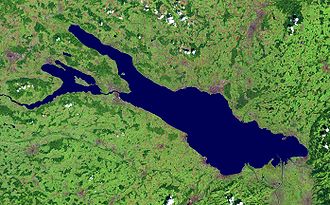
Lake Constance consists of three bodies of water: the Obersee ("upper lake"), the Untersee ("lower lake") and a connecting stretch of the Rhine, called Seerhein ("Rhine Lake"). The lake is located in Germany, Switzerland and Austria, near the Alps. Specifically, its coastlines lie in the German states of Bavaria and Baden-Württemberg, the Austrian state of Vorarlberg, and the Swiss cantons of Thurgau and St. Gallen. The Rhine flows into it from the south following the border between Switzerland and Austria. It is located at approximately 47°39′N 9°19′E / 47.650, 9.317.
Obersee
The flow of cold, gray water from the mountain continues for some distance into the lake. The cold water flows near the surface and does not initially mix with the warmer green waters of Upper Lake. But then, in the so-called Rheinbrech, the Rhine water falls steeply into the depths due to the higher density of the cold water. The flow reappears on the surface on the northern (German) lake shore, opposite the island of Lindau. The water then follows the north shoreline to Hagnau am Bodensee. A small fraction of the flow is diverted from the island of Mainau towards Lake Überlingen. Most of the water flows via the Constance hopper into the Rheinrinne ("Rhine Culvert") and Seerhein. Depending on the water level, this flow of the Rhine water is clearly visible throughout the entire length of the lake.
The Rhine carries large amounts of sediment into the lake.Cite error: <ref> tag; invalid; nameless references must have content in the mouth region, therefore gravel needs to be permanently removed by dredging. The large sediment loads are due in part to extensive upstream land improvements.
Three countries border the Obersee, namely Switzerland to the south, Austria to the southeast, and the German states of Bavaria to the northeast and Baden-Württemberg to the north and northwest.
Seerheim
The Seerheim is only 4 km long. It connects the Obersee with the Untersee, located about 30 cm lower. Distance markers along the Rhine measure the distance from the bridge in the center of the old city of Konstanz.
For most of its length, the Seerheim forms the border between Germany and Switzerland. The exception is the old town of Konstanz, on the Swiss side of the river.
The Seerheim arose in the last few thousand years, when erosion caused the lake level to drop by about 10 meters. Previously, the two lakes formed a single body, as its name suggests.
Untersee
As in the Obersee, the flow of the Rhine can be traced in the Untersee. Here, too, the river water hardly mixes with the lake waters. The northern parts of the Untersee (Lake Zell and Gnadensee) are practically unaffected by the flow. The river runs through the south, which, in isolation, is sometimes called the Rhinesee ('Rhine Lake').
The Radolfzeller Aach adds large amounts of water from the Danube system to the Untersee.
The island of Reichenau was formed at the same time as the Seerhein, when the water level dropped to its current level.
Lake Untersee is part of the Swiss-German border, with Germany on the northern shore and Switzerland on the southern, except both sides are Swiss at Stein am Rhein, the point where the Upper Rhine leaves the lake.
Haut Rhine
The Rhine emerges from Lake Constance, flows generally west like the Hochrhein, past the Rhine Falls and joins its main tributary, the Aare. The Aare more than doubles the water discharge of the Rhine, at an average of almost 1000 m³/s, and provides more than a fifth of the flow at the border Dutch. The Aare also carries waters from the 4274m summit of the Finsteraarhorn, the highest point in the Rhine basin. The Rhine roughly forms the German-Swiss border from Lake Constance, with the exception of the canton of Schaffhausen and parts of the cantons of Zürich and Basel-City, until it turns north at the so-called bend of the Rhine at Basel, leaving Switzerland.
The Upper Rhine begins at Stein am Rhein, at the western end of the Untersee. Unlike the Alpine Rhine and the Upper Rhine, it runs in a westerly direction and descends from 395 m to 252 m .
Some sections of the Upper Rhine between Stein am Rhein and Eglisau form the border between Switzerland on the south bank and Germany on the north. In other sections, both sides are Swiss; in fact, most of the canton of Schaffhausen is located on the north bank. Between Eglisau and Basel, the Upper Rhine constantly forms the border.
The Rhine Falls are located downstream of Schaffhausen. With an average water flow of 373 m³/s (summer average flow of 700 m³/s) is the largest waterfall in Europe in terms of potential energy.
The Upper Rhine is characterized by the existence of numerous dams and, in the few remaining natural sections, there are still several areas of rapids.
Near Koblenz in the canton of Aargau, the Aar joins the Rhine. With an average flow of 557 m³/s, the Aar is larger than than the Rhine, which has an average flow of 439 m³/s. However, the Alpine Rhine is considered the main branch, because it is longer.
Upper Kidney
In the center of Basel, the first major city on the river, lies the "Rhine knee"; this is a major bend, where the general direction of the Rhine changes from west to north. The Upper Rhine ends here. Legally, the Central Bridge is the boundary between the Upper and Lower Rhine. The river now flows north as the Upper Rhine through the Upper Rhine Plain, which is about 300 km long and up to 40 km wide. The most important tributaries in this area are the Ill below Strasbourg, the Neckar at Mannheim, and the Main opposite Mainz. At Mainz, the Rhine leaves the Upper Rhine Valley and flows through the Mainz Basin.
The southern half of the Upper Rhine forms the border between France (Alsace) and Germany (Baden-Württemberg). The northern part forms the border between the German states of Rhineland-Palatinate in the west, on the one hand, and Baden-Württemberg and Hesse, on the other, in the east and north. A curiosity of this border line is that the parts of the city of Mainz on the right bank of the Rhine were handed over to Hesse by the occupying forces in 1945.
The Upper Rhine was a significant cultural landscape in Central Europe already in antiquity and during the Middle Ages. Today the Upper Rhine area is home to many important manufacturing and service industries, particularly in the centers of Basel, Strasbourg and Mannheim-Ludwigshafen. Strasbourg is the seat of the European Parliament, making it one of the three European capitals located on the Upper Rhine.
The Upper Rhine region was significantly changed by a Rhine straightening program in the 19th century. The flow rate increased and the groundwater level dropped significantly. Construction work removed the dead branches and the area around the river was made more habitable for humans in the floodplains, as the flood rate dropped dramatically. On the French side, the Grand Canal de Alsace was dug, which carries a significant part of the river's water and all traffic. In some places, large compensation reservoirs exist, for example the huge "Bassin de Compensation de Plobsheim" in Alsace.
The Upper Rhine has undergone significant change since the 19th century by human action. Although it was slightly modified during the Roman occupation, it was not until the advent of engineers such as Johann Gottfried Tulla that significant modernization efforts changed the shape of the river. Earlier work under Frederick the Great focused his efforts on facilitating shipping and building dams for the transportation of coal. Tula is considered to have tamed the Upper Rhine, a domestication that served objectives such as reducing stagnant swampy areas. They fostered waterborne diseases, making those regions healthier and more habitable for human settlements, reducing the high frequency of flooding. Not long before Tula began work, heavy flooding had caused significant loss of life. Four diplomatic treaties were signed between the German state governments and the French regions related to proposed changes along the Rhine: one was the "Treaty for the Rectification of the Flow of the Rhine from Neuberg to Dettenheim" (1817), which surrounded states such as Bourbon France and the Bavarian Palatinate. Loops, meanders, branches, and islands were removed along the Upper Rhine so that there would be uniformity in the river. The engineering of the Rhine was not without protest, as many farmers and fishermen were very concerned about the loss of valuable areas of fishing and farmland. While some areas lost ground, other areas saw swamps and bogs drained and turned into arable land. Tulla had the goal of shortening and straightening the Upper Rhine, but early developments also ran into problems as rapids appeared, after the Rhine reduced erosion to pure rock. Engineering along the Rhine alleviated flooding and made transportation along the river less cumbersome. These state projects were part of the technical and advanced progress in which the country lived together with the industrial revolution. For the German state, making the river more predictable was to ensure that development projects could start easily.
The section of the Upper Rhine downstream from Mainz is also known as the "Rhine Island". Several river islands, known locally as "Rheinauen", are located here.
Middle Rhine
The Rhine is the longest river in Germany. It is here that the Rhine meets some of its main tributaries, such as the Neckar, the Main, and later the Moselle, which contributes an average flow of more than 300 m³/s. Northeastern France drains into the Rhine through the Moselle; smaller rivers drain the highlands of the Vosges and the Jura mountains. Most of Luxembourg and a very small part of Belgium also drain into the Rhine through the Moselle. As it approaches the Dutch border, the Rhine has a mean annual discharge of 2290 m³/s and a mean width of 400m.
Between Bingen am Rhein and Bonn, the Middle Rhine flows through the Rhine Gorge, a formation created by erosion. The rate of erosion matched the uplift in the region, so the river was left roughly at its original level while the surrounding lands were uplifted. The gorge is quite deep and is the section of the river known for its many castles and vineyards. It is a UNESCO World Heritage Site (2002) and known as "the romantic Rhine", with more than 40 castles and fortresses from the Middle Ages and many picturesque and charming rural villages.
- The Rhine Hünxe Germany.jpeg
The Rhine in Hünxe, near the border with the Netherlands
The Mainz basin ends at Bingen am Rhein, the Rhine continues as "Middle Rhine" in the Rhine Gorge in the Rhenish Shale Mountains. In this section the river falls from 77.4 m above sea level to 50.4 m. On the left are the Hunsrück and Eifel mountain ranges, on the right the Taunus and Westerwald. According to geologists, the narrow valley's characteristic shape was created by river erosion as the surrounding landscape was uplifted (see water gap).
The main tributaries of this section are the Lahn and the Moselle. They join the Rhine near Koblenz, on the right and on the left respectively. Almost the entire length of the Middle Rhine runs through the German state of Rhineland-Palatinate.
The dominant economic sectors in the Middle Rhine area are winemaking and tourism. The Rhine Gorge between Rüdesheim am Rhein and Koblenz is listed as a UNESCO World Heritage Site. Near Sankt Goarshausen, the Rhine flows around the famous Lorelei rock. With its outstanding architectural monuments, vineyard-filled slopes, crowded settlements on the narrow river banks, and dozens of castles lined up along the steep slopes, the Middle Rhine Valley can be considered the epitome of Rhine romanticism.
Lower Rhine
At Bonn, where the Sieg empties into the Rhine, the Rhine enters the North German Plain and becomes the Lower Rhine. The Lower Rhine falls from the 50m to 12m. The main tributaries of this section are the Ruhr and the Lippe. Like the Upper Rhine, the Lower Rhine used to meander until engineering created a solid river bed. Because the levees are some distance from the river, during high water the Lower Rhine has more room to widen than the Upper Rhine.
The Lower Rhine flows through North Rhine-Westphalia. Its shores are often densely populated and industrialized, particularly the agglomerations of Cologne, Düsseldorf, and the Ruhr area. Here the Rhine flows through Germany's largest conurbation, the Rhine-Ruhr region. One of the most important cities in this region is Duisburg with the largest river port in Europe (Duisport). The region downstream of Duisburg is more agricultural. At Wesel, 30 km downstream of Duisburg, lies the western end of the second east-west shipping route, the Wesel-Datteln canal, which runs parallel to the Lippe. Between Emmerich and Cleves the Emmerich Rhine Bridge, the longest suspension bridge in Germany, spans the 400 m wide river. Near Krefeld, the river crosses the Uerdingen line, the line that separates the areas where Low German and High German are spoken.
Until the early 1980s, industry was a major source of water pollution. Although many plants and factories can be found along the Rhine to Switzerland, it is along the Lower Rhine that most of them are concentrated, as the river passes through the major cities of Cologne, Düsseldorf and Duisburg. Duisburg is home to the largest inland port in Europe and serves as the hub for the seaports of Rotterdam, Antwerp and Amsterdam. The Ruhr, which joins the Rhine at Duisburg, is today a clean river, thanks to a combination of stricter environmental controls, a transition from heavy to light industry, and clean-up measures, such as reforestation of Slag and brownfields. The Ruhr currently provides the region with drinking water. It supplies 70 m³/s to the Rhine. Other rivers in the Ruhr area, notably the Emscher, still carry considerable pollution.
Delta
The Dutch name for the Rhine is "Rijn." The Rhine turns west and enters the Netherlands, where, together with the Meuse and Scheldt rivers, it forms the extensive Rhine-Meuse-Scheldt delta, with 25,347 km² , Europe's largest river delta. Crossing the border into the Netherlands at Spijk, near Nijmegen and Arnhem, the Rhine is at its widest, although the river later splits into three main distributaries: Waal, Nederrijn (Nether Rhine) and IJssel.
From here, the situation becomes more complicated, since the Dutch name Rijn no longer coincides with the main watercourse. Two-thirds of the Rhine's flow flows further west, through the Waal and then via the Merwede and the Nieuwe Merwede (De Biesbosch), merging with the Meuse, through the Hollands Diep and Haringvliet estuaries, into the sea from North. The Beneden Merwede forks, near Hardinxveld-Giessendam, and continues as the Noord, to join the Lek, near the village of Kinderdijk, to form the Nieuwe Maas; it then flows past Rotterdam and continues via Het Scheur and the Nieuwe Waterweg, to the North Sea. The Oude Maas branches off, near Dordrecht, and further down it joins the Nieuwe Maas to form Het Scheur.
The other third of the water flows through the Pannerdens Kanaal and is redistributed into the IJssel and Nederrijn. The branch of the IJssel carries one-ninth of the Rhine's flow north to the IJsselmeer (an old bay), while the Nederrijn carries about two-ninths of the flow west along a route parallel to the Waal. However, in Wijk bij Duurstede, the Nederrijn changes its name and becomes the Lek. It flows further west, to join the Noord at the Nieuwe Maas and the North Sea.
The name "Rijn" is henceforth used only for smaller streams further north, which together formed the main Rhine River in Roman times. Although they retained the name, these streams no longer carry water from the Rhine, but are instead used to drain the surrounding land and polders. From Wijk bij Duurstede, the former northern branch of the Rhine is called the Kromme Rijn ('Bent Rhine') passing the city of Utrecht, first the Leidse Rijn ('Leiden Rhine') and then, Oude Rijn ('Old Rhine'). The latter flows west through a lock at Katwijk, where its waters can be discharged into the North Sea. This branch formerly formed the line along which the Limes Germanicus were built. During the periods of lower sea levels within the various ice ages, the Rhine turned to the left, creating the Channel River, whose course now lies under the English Channel.
The Rhine-Meuse delta, the most important natural region of the Netherlands, begins near Millingen aan de Rijn, close to the Dutch-German border with the division of the Rhine into the Waal and the Nederrijn. The region between the Dutch-German border and Rotterdam, where the Waal, the Lek and the Meuse run more or less parallel, is colloquially known as the 'Great Rivers'. Since the Rhine supplies most of the water, the shorter term Rhine delta is commonly used. However, this name is also used for the delta where the Rhine empties into Lake Constance, so it is clearer to call it lee. Rhine-Meuse delta, or even the Rhine-Meuse-Scheldt delta, since the Scheldt ends in the same delta.
The shape of the Rhine delta is determined by two forks: first, at Millingen aan de Rijn, the Rhine splits into the Waal and Pannerdens Kanaal, which changes its name to Nederrijn en Angeren, and second near Arnhem, the IJssel it branches off the Nederrijn. This creates three main channels, two of which change names quite frequently. The southern branch, the main and largest, begins as Waal and continues as Boven Merwede ('Upper Merwede'), Beneden Merwede ('Lower Merwede'), Noord ('Lower Merwede'). the North'), Nieuwe Maas ('New Meuse'), Het Scheur ('the Tear') and Nieuwe Waterweg ('New Waterway'). The middle channel starts as Nederrijn, then changes to Lek,, then joins the Noord, thus forming the Nieuwe Maas. The northern channel retains the name IJssel until it empties into the IJsselmeer lake. Three more channels carry significant amounts of water: the Nieuwe Merwede ('New Merwede'), which branches off from the southern arm where it changes from Boven to Beneden Merwede; the Oude Maas ('Old Meuse'), which branches off from the southern branch where it changes from Beneden Merwede to Noord, and the Dordtse Kil, which branches off from the Oude Maas.
Before the St Elizabeth's flood (1421), the Meuse flowed just south of the present Merwede-Oude Maas line into the North Sea and formed an archipelago-like estuary with the Waal and Lek. This system of numerous bays, extensive rivers like estuaries, many islands and constant changes of the coast, is difficult to imagine today. From 1421 to 1904, the Meuse and the Waal merged upriver at Gorinchem to form the Merwede. For flood protection reasons, the Meuse was separated from the Waal through a lock and diverted to a new outlet called Bergse Maas, then Amer and then flows into the former Hollands Diep bay.
The northwestern part of the estuary (around the Hook of Holland), is still called Maasmond ("Mouth of the Meuse"), ignoring the fact that it now only carries water from the Rin. This could explain the confusing naming of the various branches. Today's delta hydrography is characterized by main delta arms, disconnected arms (Hollandse IJssel, Linge, Vecht, etc.) and smaller rivers and streams. Many rivers have been closed ('dammed') and now serve as drainage channels for the many polders. The construction of the Delta Works radically changed the delta in the second half of the 20th century. Currently, the water of the Rhine flows into the sea, or into former marine bays now separated from the sea, in five places, namely at the mouths of the Nieuwe Merwede, Nieuwe Waterway (Nieuwe Maas), Dordtse Kil, Spui and IJssel.
The Rhine-Meuse delta is a tidal delta, formed not only by sedimentation from rivers, but also by tidal currents. This meant that high tide posed a serious risk because strong tidal currents could tear large tracts of land out to sea. Before the construction of the Delta Works, the influence of the tides was palpable as far as Nijmegen, and even today, after the regulatory action of the Delta Works, the tide acts inland. In the Waal, for example, the more inland tidal influence can be detected between Brakel and Zaltbommel.
Tour
It is born in the Swiss Alps (Canton of Grisons) and serves as a natural border with Liechtenstein where the Former Rhine (which comes from the Saint Gotthard/Oberalp massif) and the Posterior Rhine (which comes from the Albula massif) meet.. After leaving Grisons, Liechtenstein and Austria, it empties into Lake Constance, in a vertiginous descent from the Rhine Horn (Rheinwaldhorn) to 3402 m to relatively lake bass 395. It then passes through Basel, serving as the border between France and Germany, entering the industrial Ruhr region and turning towards the Netherlands, where it divides into three main arms - IJssel, Waal and Lek - before flowing into the sea. North, forming a common delta with the river Meuse. The main ports on the Rhine are Rotterdam, Duisburg, Mannheim, Ludwigshafen, Strasbourg and Basel. The Rhine basin supplies all its water to the Duchy of Luxembourg. In fact, this country appears in all the river treaties.
Hydrographic regime
The hydrological regime of the Rhine is harmonious, all its tributaries make complementary contributions: Aar (610 m³/s), Ill (58 m³/s), Neckar (145 m³/s), Meno (Main) (190 m³/ s), Moselle (400 m³/s), Lippe (100 m³/s), Ruhr (80 m³/s).
His Lake Constance regime is snowy and has a tendency to reduce his vitality. Then the Schaffhausen waterfall, which receives abundant water and is marked by the imprint of glaciers. The Rhine brings 410 m³/s and the Aar 610 m³/s, and they reach Basel with a flow of 1030 m³/s with a maximum in June and a minimum in January. The Rhine flows with approximately half of its volume to 20% of its basin.
In Strasbourg, which receives the waters of the Ill, which offers about 58 m³/s, its snow regime attenuates to a certain degree. It is losing this type of regime, since it is progressively receiving tributaries of pluvial regime with a high winter water content. The contributions of the Neckar and the Meno (Main) tend to regulate its flow. But it is in Koblenz that the Rhine loses its snow regime and starts to have a pluvial-snow regime, with a moment of maximum contribution with the contribution of the Moselle (400 m³/s), and the maximum characteristic of the winter period. Starting from Koblenz, its maximum in winter (in February it is 2540 m³/s) is higher than in summer (in June it is 2090 m³/s), reaching its minimum in October (1480 m³/s). Its average flow of 2000 m³/s. Subsequently, it receives little from the main tributaries, apart from the contributions of the Lippe, and the Ruhr basin, which already contribute in Lobith (Gelderland) to make the flow reach 2300 m³/s.

Monthly median flow (in m³/s) measured at the Ress hydrological station. Altitude: 2 m- basin covering: 185,000 km² - calculated over the period 1930-1997.
Economy
The Rhine basin is one of the most densely populated and intensively industrialized in the world. It is the most important fluvial artery in the world due to the density of its commercial navigation traffic.
Since the Mannheim Convention of 1868, the Rhine has been considered a region of "international waters" from the last bridge in Basel to the North Sea, ensuring Switzerland free access to the sea. The headquarters of the Central Commission for the Navigation of the Rhine (CCNR) is in Strasbourg. Founded in 1815 during the Congress of Vienna, it is the oldest international organization.
Channels
The course of the Rhine is marked by numerous canals, which run parallel to it (the Alsace canal) or connect it with other rivers: the Saint-Symphorien canal (with the Rhône-Saone) or the Rhine-Main-Danube.
- Grand Canal de Alsace
The construction of the Grand Canal de Alsace, on the French side, from 1920 allowed France to build a series of hydroelectric power plants and dams on its territory, which lowered the level of the Rhine. As a consequence, In 1935, salmon had completely disappeared, also making this river the most polluted on the continent.
Thanks to the coordinated efforts of the riparian nations, the river has now regained its purity and salmon have reappeared in its waters.
- Rin-Meno-Danubio Canal
It runs through the southern half of Germany at 677 km in length. This river link, started after the First World War and completed in 1993, stretches across German Bavaria from Aschaffenburg (extreme northwest) to the vicinity of Passau, near the Austrian border. It passes through the valleys of the rivers Meno (Main in German), Regnitz and Altmühl and allows navigation from the North Sea to the Black Sea.
The Rhine in Germany
For several supporters of German unification in the 19th century, the emerging national identity was epitomized by the wild spaces of Germany. "Memories of what the Germans once were and might be in the future are not evoked as clearly as on the Rhine," Friedrich Schlegel wrote in 1803.
The Rhine is vital for industry in Germany as it not only acts as a distribution route for raw materials, but also serves to transport final products to the port of Rotterdam, the largest in Europe. In 2018, close to the 80% of the 220 million tons of cargo transported in Germany passed through the Rhine.
The annual Rhine in Flames festival features a fireworks display in Sankt Goar in September and in Koblenz in August.
History
During prehistoric times, the same cultural groups existed on both sides of the river. The national border characteristic of the Rhine is relatively recent, with the exception of the period during which the Roman Empire transformed it into its northern barrier against the barbarians, as a frontier (limes) full of fortifications, like Cologne. Between the fall of the Roman Empire and Louis XIV's conquest of Alsace, the Rhine formed an exclusive part of the Germanic world.
In early historical times, the Germanic tribes settled on both sides of the lower part of the river, and the Celts along its upper course. During the Roman Empire, the Battle of the Teutoburg Forest (Year 9) in the one that the Roman troops to the north of the Rhine (three legions) were annihilated by the cherusci of Arminio, so that Augusto decided to establish the Rhine as the northern border of the empire temporarily.
On New Year's Eve 405 or 406 (there are reasoned differing opinions in historiography), the Suevi, Alans, and Vandals crossed the frozen Rhine through Mainz, and later devastated Gaul and invaded the Western Roman Empire.
Trade flourished along the Rhine in Roman times, while Cologne, thanks mainly to basic law, became a metropolis.
Contemporary Age
In 1806, during the First French Empire, the Confederation of the Rhine was established, imposed by Napoleon Bonaparte to the detriment of the Holy Roman Empire.
The Rhine has historically been a source of border problems between France and Germany. For example, in 1840 the Rhine crisis evolved as French Prime Minister Adolphe Thiers began to talk about the Rhine frontier. The nationalist song "The Guard by the Rhine" ("Die Wacht am Rhein") was composed at that time and during the Franco-Prussian War of 1870 it rose to the status of the German national anthem. The song calls for the defense of the Rhine against France and remained popular during World War I.
After the end of the war, the Treaty of Versailles (1919) specified the indefinite demilitarization of the Rhineland. These were the territories between the French border and the Rhine, plus a strip of 50 km east of the Rhine. The Rhineland would also be occupied by Allied troops for 15 years, until 1935 (after the Locarno Treaty, the allied troops would withdraw from the Rhineland in 1930). This clause created bitterness in Germany and is considered one of the causes of World War II. The reoccupation and militarization of the Rhineland by Nazi Germany (1936) was followed by a referendum to ratify the action that had been illegally ordered by führer Adolf Hitler. 45 million voted and the referendum was won by the Berlin government with 99% of the votes.
World Heritage Site
The Upper Middle Rhine Valley, between Bingen and Koblenz, was declared a UNESCO World Heritage Site in 2002. The Lorelei Crag is one of the most admired by tourists.
Tributaries
| Ramal | Pto. km. | Quote | Affluent name | Destroying | Length (km) | Cuenca (km2) | Caudal (m3/s) | subentity where it flows | Section | |||||
| - | D | ? | ? | Ill | Rin | 76 | 1281 | 66 | Vorarlberg | Austria | ||||
| - | D | ? | ? | Bregenzer Ach | Lake Constance | 70 | 835 | 41 | ||||||
| - | D | ? | ? | Argen | Lake Constance | 94 | 639 | 19.5 | Germany | |||||
| - | D | ? | ? | Schussen | Lake Constance | 62 | 782 | 10.9 | ||||||
| I | - | 65.0 | 345 | Thur | Rin | 134.6 | 1696 | 45.5 | Switzerland | |||||
| - | D | 100.17 | ? | Wutach | Rin | 90.2 | 1123 | 16 | Baden-Wurtemberg | Germany and Switzerland | ||||
| I | - | 102.2 | 311 | Rio Aar | Rin | 288,24 | 17 620 | 590 | Switzerland | |||||
| - | - | - | - | - | Sarine | Aar | 126 | 1892 | 20 | |||||
| - | - | - | - | - | Rio Emme | Aar | 81.9 | 983 | 19.8 | |||||
| - | - | - | - | - | River Reuss | Aar | 164.4 | 3425 | 140 | |||||
| - | - | - | - | - | Río Limago | Aar | 140 | 2416 | 85.9 | |||||
| - | - | - | - | - | - | Sihl River | Río Limago | 73 | 314 | 5,19 | ||||
| I | - | 164.49 | ? | Birse | Rin | 73 | 924 | 15 | ||||||
| - | D | 169.3 | River Wiese | Rin | 58 | 453 | 12 | Germany | ||||||
| - | D | 253 | 154 | Rio Elz | Rin | 90 | 1481 | 21,5 | ||||||
| - | D | 298.16 | 134 | Kinzig river | Rin | 95 | 1406 | 22.9 | ||||||
| I | - | 311.7 | 127 | Rio Ill | Rin | 208 | 4760 | 45 | France | |||||
| - | - | - | - | - | Largue | Ill | 75 | 277 | 2.97 | |||||
| - | - | - | - | - | Bruche | Ill | 76.8 | 727 | 7.9 | |||||
| I | - | 334.5 | 113 | Rio Moder | Rin | 93 | 1720 | 16.6 | ||||||
| - | - | - | - | - | Zorn | Moder | 102. | 757 | 7.41 | |||||
| I | - | 343.95 | ? | Sauer | Rin | 70 | 806 | 6.07 | ||||||
| - | D | 344.45 | ? | Murg | Rin | 79 | 617 | 18 | Germany | |||||
| I | - | 355.5 | ? | Lauter River | Rin | 74 | 382 | 3 | ||||||
| - | D | 370.0 | ? | Pfinz | Rin | 60 | 240 | 2.06 | ||||||
| I | - | 400.2 | ? | Speyerbach | Rin | 60 | 596 | 2.27 | ||||||
| - | D | 428.2 | 95 | Neckar | Rin | 367 | 14 000 | 145 | Baden-Wurtemberg | |||||
| - | - | - | - | - | Filters | Neckar | 63 | 704 | 10.1 | |||||
| - | - | - | - | - | Rems | Neckar | 78 | 567 | 6.98 | Baden-Wurtemberg | ||||
| - | - | - | - | - | Enz | Neckar | 105.3 | 2228 | 23,03 | Baden-Wurtemberg | ||||
| - | - | - | - | - | - | Rio Nagold | Enz | 92 | 7.82 | Baden-Wurtemberg | ||||
| - | - | - | - | - | Kocher River | Neckar | 182 | 1932 | 7.81 | Baden-Wurtemberg | ||||
| - | - | - | - | - | Jagst | Neckar | 189 | 1830 | 18,60 | Baden-Wurtemberg | ||||
| - | - | - | - | - | Eyach | Neckar | 50 | 349 | 3,41 | Baden-Wurtemberg | ||||
| - | D | 496.5 | 82 | Meno (Main) | Rin | 524 | 27 292 | 225 | ||||||
| - | - | - | - | - | Itz | Meno | 80 | 1029 | 9,29 | |||||
| - | - | - | - | - | Wern | Meno | 63.46 | 602 | ||||||
| - | - | - | - | - | Saale Franconio | Meno | 135 | 2765 | 175 | |||||
| - | - | - | - | - | Tauber | Meno | 130.63 | 1810 | 9,29 | |||||
| - | - | - | - | - | Kinzig | Meno | 86 | 1058 | 10,84 | |||||
| - | - | - | - | - | Nidda | Meno | 89.7 | 1942 | 13,06 | |||||
| - | - | - | - | - | - | Wetter | Nidda | 68.8 | 517 | 29,93 | ||||
| - | - | - | - | - | - | Nidder | Nidda | 68.6 | 436 | 38,75 | ||||
| I | - | 518.7 | ? | Selz | Rin | 63 | 389 | 0.77 | ||||||
| I | - | 529.2 | 79 | Rio Nahe | Rin | 125 | 4067 | 30.3 | Renania-Palatinado and Sarre | |||||
| - | - | - | - | - | Glan | Nahe | 89.7 | 1222 | ||||||
| - | D | 585.8 | 61 | Lahn | Rin | 245,6 | 5924 | 49.5 | North-Westphalia, Hesse and Renania-Palatinado | |||||
| - | - | - | - | - | Ohm | Lahn | 59.8 | 984 | 7.95 | |||||
| I | - | 592.3 | 59 | Río Mosela | Rin | 544 | 28 286 | 428 | France, Luxembourg and Germany | |||||
| - | - | - | - | - | Meurthe | Moselle | 161 | 3085 | 20 | France | ||||
| - | - | - | - | - | - | Mortagne | Meurthe | 75 | 582 | 6.72 | ||||
| - | - | - | - | - | - | Vezouze | Meurthe | 75 | 563 | 6.82 | ||||
| - | - | - | - | - | Seille | Moselle | 138 | 1348 | 10 | |||||
| - | - | - | - | - | Río Sarre (Saar) | Moselle | 227 | 7431 | 75 | Great East (FR), Sarre and Renania-Palatinate (DEU) | France and Germany | |||
| - | - | - | - | - | - | Blies | Sarre | 99.5 | 1960 | 19.2 | Germany and France | |||
| - | - | - | - | - | - | Prims | Sarre | 91 | 11 | Germany | ||||
| - | - | - | - | - | - | Nied | Sarre | 114 | 1370 | 13 | Germany and France | |||
| - | - | - | - | - | Madon | Moselle | 98 | 1032 | 11,1 | France | ||||
| - | - | - | - | - | Orne | Moselle | 80 | 1268 | 12 | |||||
| - | - | - | - | - | Sauer | Moselle | 173 | 4259 | 34 | Belgium, Luxembourg and Germany | ||||
| - | - | - | - | - | - | Alzette | Sauer | 73 | 1172 | 11 | France and Luxembourg | |||
| - | - | - | - | - | - | Our | Sauer | 78 | 187 | 10 | Belgium, Luxembourg and Germany | |||
| - | - | - | - | - | - | Prüm | Sauer | 85 | 573 | Germany | ||||
| - | - | - | - | - | - | - | Nims | Prüm | 59 | 264 | ||||
| - | - | - | - | - | Kyll | Moselle | 142 | 834 | ||||||
| - | - | - | - | - | Lieser | Moselle | 73.6 | 402 | ||||||
| - | - | - | - | - | Salm | Moselle | 63.4 | 298 | ||||||
| - | - | - | - | - | River Elz | Moselle | 58.9 | 221 | ||||||
| - | D | 610.2 | ? | Wied | Rin | 102. | 771 | |||||||
| I | - | 629.4 | ? | River Ahr | Rin | 89 | 900 | North Rhine-Westphalia, Renania-Palatinado | ||||||
| - | D | 659,3 | ? | Sieg River | Rin | 155.2 | 2832 | 56.6 | North Rhine-Westphalia and Rhineland-Palatinate | |||||
| - | - | - | - | - | Nister | Sieg | 64 | 246 | ||||||
| - | - | - | - | - | Agger | Sieg | 69.5 | 816 | ||||||
| - | D | 703.3 | ? | Wupper | Rin | 116.5 | 827 | 15.4 | North Rhine-Westphalia | |||||
| I | - | 735.5 | ? | Río Erft | Rin | 106.6 | 1838 | 16 | ||||||
| - | D | 780.2 | 20.2 | Ruhr River | Rin | 219,3 | 4485 | 76.3 | ||||||
| - | - | - | - | - | Möhne | Ruhr | 65.1 | 469 | ||||||
| - | - | - | - | - | Lenne | Ruhr | 129.1 | 1352 | 30.3 | |||||
| - | D | 797.7 | ? | Emscher | Rin | 83.1 | 775 | 16 | ||||||
| - | D | 814,5 | 18 | Rio Lippe | Rin | 220.1 | 4888 | 46 | ||||||
| - | - | - | - | - | Alme | Lippe | 59.1 | 763 | 4.6 | |||||
| I | - | 925.5 | ? | Mosa River (Maas) (1904-1970 independent) | Rin | 925 | 34 548 | 400 | France, Belgium and the Netherlands | |||||
| - | D | ? | ? | Rio IJssel (Delta) | Rin | 123 | 280 | Netherlands | ||||||
| - | - | - | - | - | Berkel | IJssel | 114.6 | 849 | 9 | Germany and the Netherlands | ||||
| - | - | - | - | - | Schipbeek | IJssel | 85.3 | 352 | 4 | Germany and the Netherlands | ||||
| - | - | - | - | - | Vechte | IJssel | 182 | 5741 | 50 | Germany and the Netherlands | ||||
International Law
Foreseen at the Congress of Vienna, the regime for the internationalization of the Rhine was established by the conventions of Mainz (1831) and Mannheim (1868). The Central Commission for the Navigation of the Rhine included the representatives of the riparian States; it drew up projects and adjudicated disputes relating to navigation on the Rhine. Modified by the Treaty of Versailles (1919) and resumed after World War II, the regime is now more open and more restrictive, as the Commission has real regulatory power.
The Rhine in culture
The bridge over the Rhine in Arnhem (Netherlands), was the scene of the Battle of Arnhem during the failed Operation Market Garden in September 1944, central plot of the Richard Attenborough film A Bridge Too Far (A bridge too far away).
The bridge over the Rhine in Remagen also became famous during World War II – a film with the same name was shot The Remagen Bridge – when the Wehrmacht was unable to demolish the bridge at time, surprisingly allowing the allied troops to establish a bridgehead in German territory.
Contenido relacionado
Charlotte of Mexico
Girona
Paradores of Tourism of Spain



